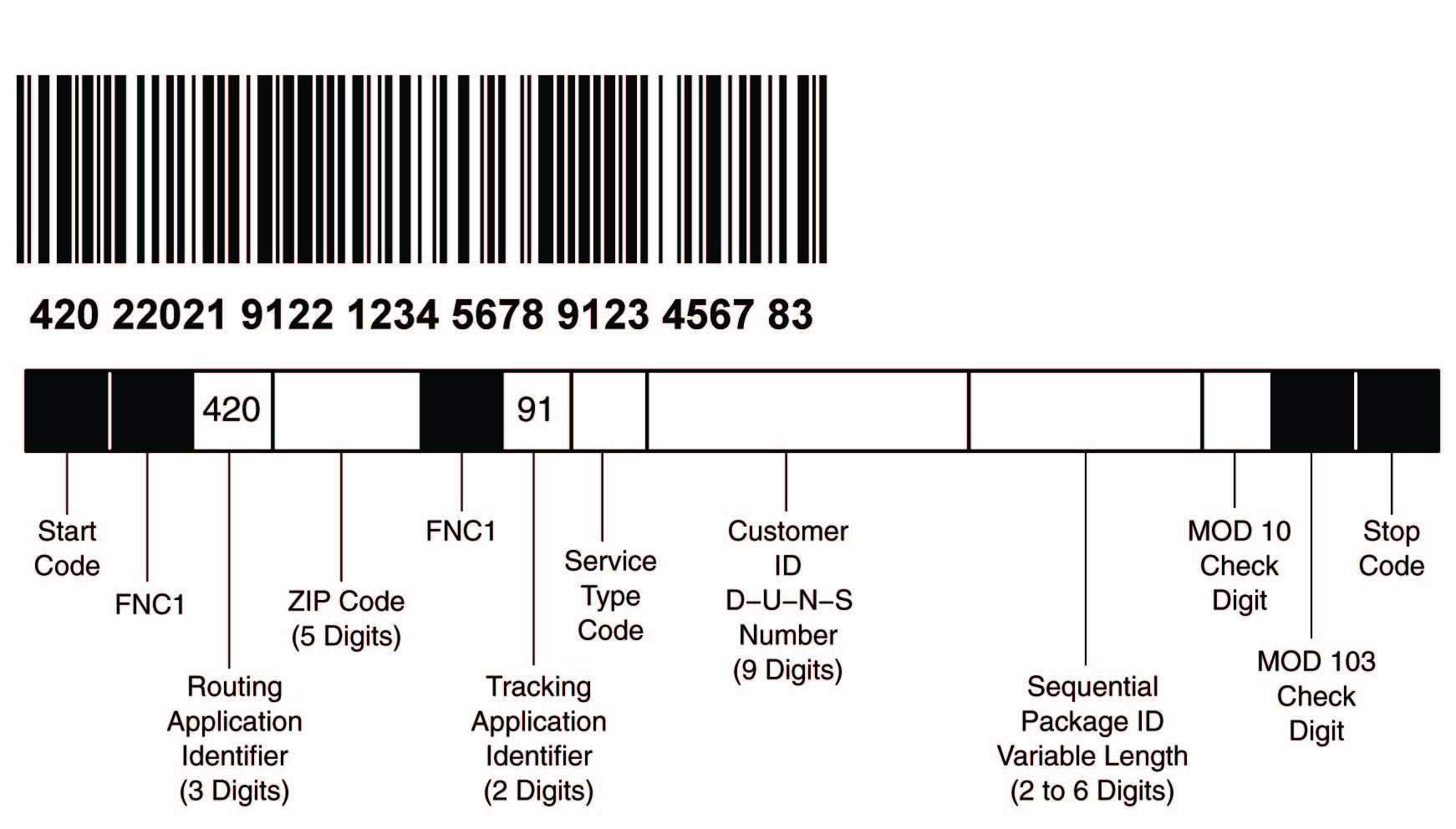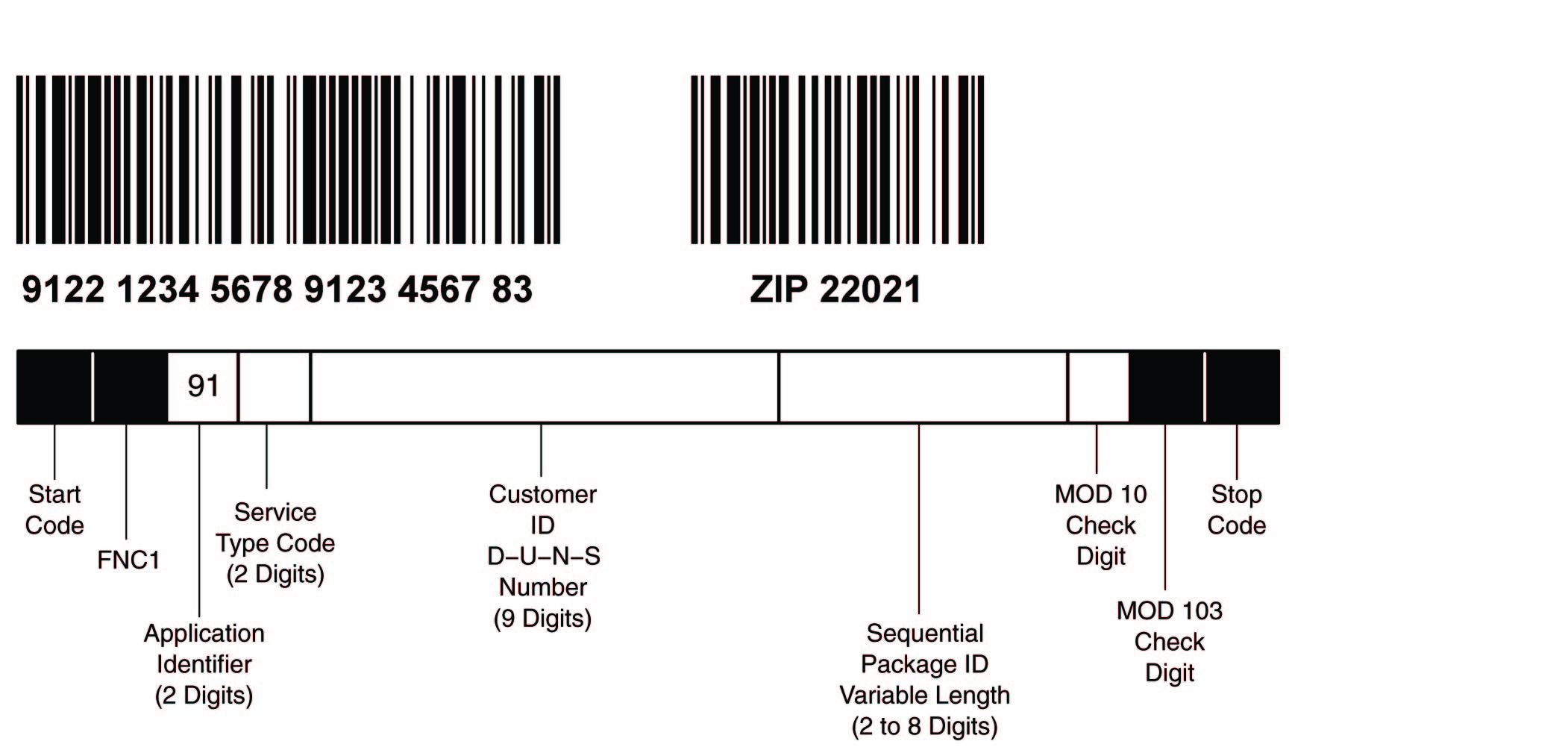 |
 |
C800 Automation-Compatible Mail
C850 Barcoding Standards for Parcels
Summary
C850 describes the technical standards for all barcoded parcels. It defines parcel barcode characteristics, location, and content.
1.0 General
1.1Basic Requirements for Postal Routing
Barcodes
[11-11-04] [3-4-04] The postal routing barcode discount applies to machinable parcels that meet the eligibility requirements in E610.5.4, E711.2.2, E712.3.0, E713.2.0, or E714.2.0. To be eligible for the barcode discount, each machinable parcel (see C050) must bear a properly prepared UCC/EAN Code 128 barcode symbology as described in 1.3 that accurately represents the correct ZIP Code or ZIP+4 code of the delivery address.
1.2Basic Elements of Postal Routing
Barcodes
[11-11-04] UCC/EAN Code128 postal routing barcode data elements (see Exhibit 1.2) include:
a. Barcode Type. UCC/EAN Code128 is the only acceptable barcode and must be printed within Subset C.
b. Start Code. Postal routing barcodes must start with a Symbol Start Code, which is not shown in the human-readable text.
c. Function One (FNC1). The FNC1 numeric character for UCC/EAN Code128 follows the symbol start character, is part of the symbology overhead, and is not shown in the human-readable text.
d. Application Identifier (AI). The AI for a postal routing barcode is “420” for domestic mail and is not shown in the human-readable text.
e. ZIP Code or ZIP+4 Code. Postal routing barcodes must include the 5-digit ZIP Code or ZIP+4 code of the address. Only the 5-digit ZIP Code appears in the human-readable text.
f. Check Digit. A check digit must be added at the end of the sequence of numbers to validate the authenticity of the number. UCC/EAN Code128 postal routing barcodes must utilize a MOD 103 check digit, which is not shown in the human-readable text.
g. Stop Code. The UCC/EAN Code128 postal routing barcode must end with a Symbol Stop Code, which is not shown in the human-readable text.
Exhibit 1.2Postal Routing UCC/EAN Code 128 Barcode
Format [11-11-04]

1.3Use With Delivery Confirmation or
Signature Confirmation Service
[11-11-04] [3-4-04] Eligible machinable parcels may qualify for the barcode discount and bear a Delivery Confirmation or Signature Confirmation barcode using one of the following options:
a. The Single Concatenated Barcode (see Exhibit 1.3a). Mailers may place a single concatenated barcode that combines the postal routing information and Delivery Confirmation or Signature Confirmation information. Single concatenated barcodes must be prepared in accordance with the technical specifications and requirements in S918 for Delivery Confirmation service, S919 for Signature Confirmation service, and Publication 91, Confirmation Services Technical Guide. If a parcel bears a single concatenated barcode, then no other barcode that contains the postal routing barcode may be affixed to the package.
b. Separate Barcodes (see Exhibit 1.3b). Mailers may place both a postal routing barcode described in 1.2 and a Delivery Confirmation barcode described in S918 or a Signature Confirmation barcode described in S919 (and Publication 91) on the same parcel.
Exhibit 1.3aConfirmation Services
Concatenated UCC/EAN Code 128 Barcode Format
[11-11-04]

Exhibit 1.3bConfirmation
Services UCC/EAN Code 128 Barcode Format Using
a Separate Postal Routing Barcode
[11-11-04]

1.4Use With Confirmation Services
and Insurance (Integrated Barcode)
[11-11-04] [3-4-04] To eliminate the need to place one barcode for Delivery Confirmation or Signature Confirmation and another barcode for insurance, eligible machinable parcels may qualify for the barcode discount by placing a single integrated barcode that combines Delivery Confirmation or Signature Confirmation and insurance using one of the following options:
a. Single Concatenated Integrated Barcode. Mailers may place a single concatenated integrated barcode that combines postal routing information and postal insurance (see S913) with Delivery Confirmation service or Signature Confirmation service. The single concatenated integrated barcode option allows electronic option mailers to combine multiple special services into a single barcode on their packages. Single concatenated integrated barcodes must be prepared in accordance with the technical specifications and requirements in S918 for Delivery Confirmation service, S919 for Signature Confirmation service, and Publication 91. If a parcel bears a single concatenated integrated barcode then no other barcode that contains the postal routing barcode may be affixed to the package.
b. Separate Barcodes. Mailers may place both a postal routing barcode described in 1.2 and an integrated barcode that combines insurance as described in 1.4a on the same parcel with Delivery Confirmation in S918 or Signature Confirmation in S919. The integrated barcode option allows electronic mailers to combine multiple special services into a single barcode on their packages.
2.0 Barcode Characteristics
2.1Dimensions
[11-11-04] The preferred range of widths of narrow bars and spaces is 0.015 inch to 0.017 inch. The width of the narrow bars or spaces must be at least 0.013 inch but no more than 0.021 inch. All bars must be at least 0.75 inch high.
2.2Clear Zone
[3-4-04] The barcode must be located as specified in 3.0. No printing may appear in an area 1/8 inch above and below the barcode. A minimum clear (quiet) zone equal to 10 times the average measured narrow element (bars or space) width must be maintained to the left and right of the barcode.
2.3Reflectance
When measured in the red spectral range between 630 nanometers and 675 nanometers, the minimum white bar (space) reflectance (Rs) must be greater than 50%, and the maximum bar reflectance (Rb) must be less than 25%. The minimum print reflectance difference (Rs-Rb) is 40%. Reflectance must be measured with a USPS-specified reflectance meter or barcode verifier.
2.4Quality
[3-4-04] All barcodes in each mailing must measure American National Standards Institute (ANSI) grade C or above. ANSI grade barcodes D or F are unacceptable. It is strongly recommended that all printing processes be tested to ensure that they meet specification requirements. Information concerning ANSI guidelines X3.182-1990 may be obtained from the American National Standards Institute (see G043).
2.5Human-Readable Information
[11-11-04] [3-4-04] The human-readable information on the barcode must conform to one of the following options:
a. For postal routing barcodes printed under 1.2, 1.3b, and 1.4b, if the postal routing barcode is printed on a separate label, the human-readable equivalent of the ZIP Code or ZIP+4 code encoded in the barcode preceded by the word “ZIP” must be printed between 1/8 inch and 1/2 inch below the barcode in 10-point or larger bold sans-serif type. Alternatively, the word “ZIP” may be placed no less than 10 times the average narrow bar or space element width and no more than 1/2 inch to the left of the barcode, in 10-point or larger bold sans-serif type (see Exhibit 1.2). While not recommended, if the postal routing barcode is printed on the delivery address label and is in close proximity to the address, the human-readable equivalent of the ZIP Code (and the word “ZIP”) may be omitted.
b. For barcodes printed under 1.3b or 1.4b the human-readable information for the concatenated or concatenated/integrated barcode must include as text the application identifiers (AI) 420 and 91 and the full tracking identification number. When the AI 420 and ZIP Code information is used, it must be parsed separately from the main body of text. The first group will contain the 420 AI, space, 5-digit ZIP Code, space, +4 code (if used), space, with the remaining human-readable text parsed in groups of four with the remaining digits grouped at the end (e.g., 420 22021 9122 1234 5678 9123 4567 83).
2.6Technical Specifications
[3-4-04] Postal routing codes must meet the technical specifications in the UCC/EAN-128 Application Identifier Standard, which can be obtained from Uniform Code Council Inc. (see G043), and the barcode characteristics in 2.0.
2.7Substrate Material
[3-4-04] Barcodes must be printed on substrate material that preserves the optical specification as described in the AIM-USA Uniform Symbology Specification documents. Typically, white label stock commonly used for barcode generation is suitable, providing it is not glossy (causing mirror-like, specular reflection) or prone to smearing or smudging.
3.0 Barcode Location
[3-4-04] The address and barcode must be placed squarely onto the largest surface area of the parcel, except when its shape and contents requires specific orientation for stability during processing; then the address and barcode(s) must be placed on the top. The address and barcode label(s) must not overlap any side of the parcel or other label. The barcode should be placed immediately adjacent to the delivery address and at least 1 inch from the edge of the parcel. The delivery address and barcode may be printed on an attachment or enclosure in a window envelope affixed to the parcel, subject to the reflectance standards in 2.3. The barcode may be placed on a separate label or in an alternate location on the address label, subject to the clearance standards in 2.2. Barcodes that are not placed immediately adjacent to the delivery address must not encroach the return address, postage, applicable markings, endorsements, and special service labels.
DMM Issue 58 Updated 12-9-04